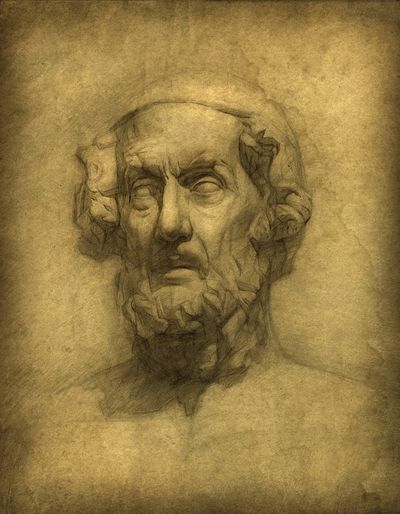More actions
m Tweak. |
Update after move. |
||
| (2 intermediate revisions by the same user not shown) | |||
| Line 1: | Line 1: | ||
{{jt|title=O My Rider}} | |||
{{hatnote|The following was written for the [[100 Words|100-Word challenge]]. It should have exactly 100 words.}} | {{hatnote|The following was written for the [[100 Words|100-Word challenge]]. It should have exactly 100 words.}} | ||
[[File:Homer-drawing.jpeg|thumb|400px|Drawing of Homer by Yaroslav Gerzhedovich.]] | |||
{{Big|In book XVI of Homer’s ''Iliad'', the narrator employs the poetic device of '''[[Wikipedia:Apostrophe (figure of speech)|apostrophe]]''' several times. The ''[[Wikipedia:Rhapsode|rhapsode]]'' occasionally addresses Patroclus as “O my rider” breaking out of his third-person point-of-view. With this interjection, the narrator calls attention to Patroclus and aligns the audience’s sympathies with him. From the outset, [[Fighting Beyond Fate|Patroclus’ death is foretold]], but the ''apostrophe'' emphasizes the impending doom with a pathos that no other characters receive. Literally, Patroclus rides in a chariot, but “rider” could also suggest that he is riding on the waves of fate, washing him to his doom.}} | |||
{{Epic|state=expanded}} | |||
{{2019|state=collapsed}} | |||
{{ | |||
[[Category:Homer]] | [[Category:Homer]] | ||
Latest revision as of 06:47, 17 May 2023
O My Rider

In book XVI of Homer’s Iliad, the narrator employs the poetic device of apostrophe several times. The rhapsode occasionally addresses Patroclus as “O my rider” breaking out of his third-person point-of-view. With this interjection, the narrator calls attention to Patroclus and aligns the audience’s sympathies with him. From the outset, Patroclus’ death is foretold, but the apostrophe emphasizes the impending doom with a pathos that no other characters receive. Literally, Patroclus rides in a chariot, but “rider” could also suggest that he is riding on the waves of fate, washing him to his doom.
